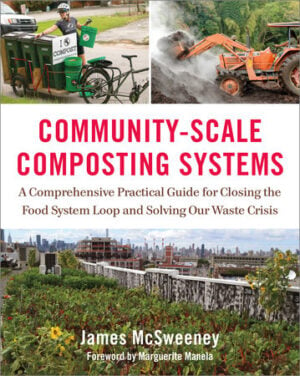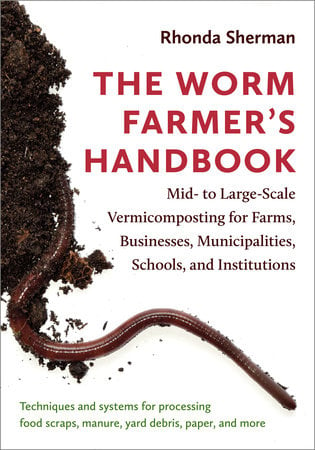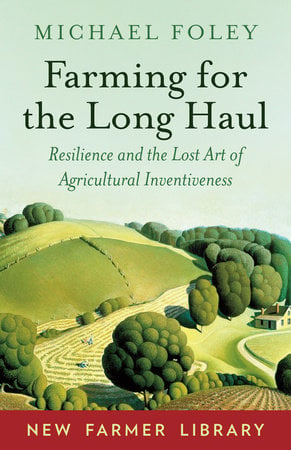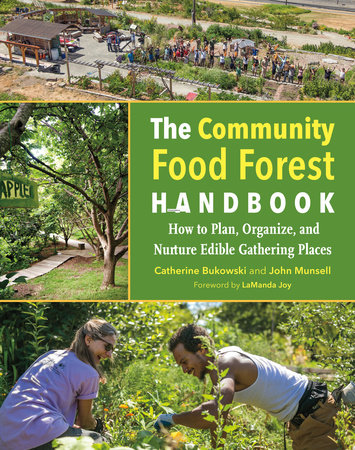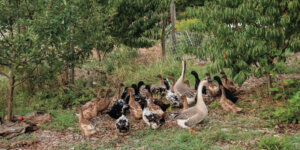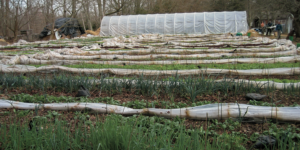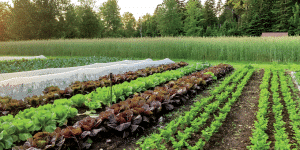Composting with Animals: Common Applications
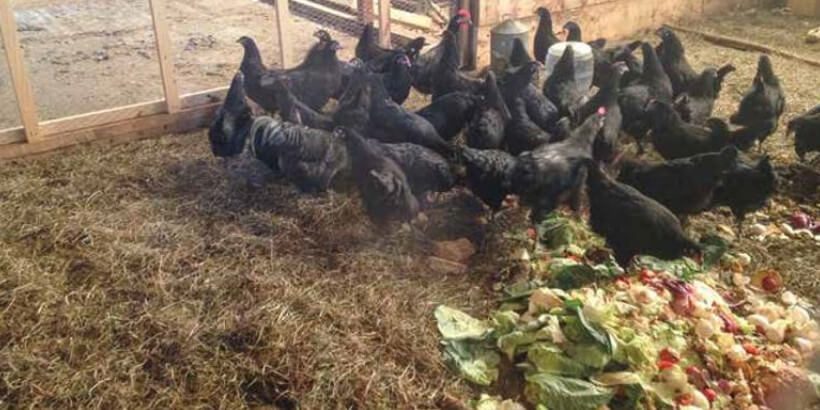
When you think of a typical farm, you probably think of going out to feed the animals with a bucket of scraps. This has been one of the most common ways to recycle food for many years and helps reduce your waste footprint. However, composting with the help of animals is another technique used on farms, though it is more complex than plain composting.
The following is an excerpt from Community-Scale Composting Systems by James McSweeney. It has been adapted for the web.
As any farmer who has integrated animals and composting in their operation can tell you, it’s not for everyone. Raising livestock is called animal husbandry for a reason: Livestock require consistent care and should essentially be thought of as a separate business from composting altogether in terms of the skill sets and management involved.
The converse is also true: Livestock operations that are considering using food scraps as feed need to manage these unique feed sources appropriately, and the most likely route to do so is through managed composting. So composting with animals is a solution both for composters who want to farm and for farmers who want to compost. I say this because if you are inclined, as many entrepreneurial types are, to continuously add business components, consider the benefits, but also weigh the additional operational requirements and business prospects for doing so successfully.
For those considering food scraps as animal feed, if you’re unfamiliar with the landscape, I would recommend stepping back for a minute to look at who’s already doing what and why. The most important thing to understand is that not all upcycled feed sources or livestock species are equivalent or treated the same in the eyes of the law. To add a compounding factor, regulations vary dramatically from state to state, so depending upon what state you are operating in, regulations may limit your options. Essentially, the animals you want to raise need to be compatible with both the feed sources that are available to you and your regulatory environment.
In 2016 the Harvard Food Law and Policy Clinic published Leftovers for Livestock: A Legal Guide for Using Excess Food as Animal Feed, which outlines the laws from state to state. The net effect of so much regulatory variability is similar variation in animal feeding practices across the country. From working in the organics recycling field, I know that many large generators of non-meat residuals (food processing/ manufacturing generators) already divert food to hogs, and cows to a lesser degree, on a large scale. My experience is that large volumes of very consistent material from the food manufacturing sector are mostly spoken for as either hog or cow feed, and also as feedstock for anaerobic digesters. Anecdotally at least, medium- and large-scale chicken farms do not appear to be recycling food to the same degree, despite the fact that in many parts of the United States, food residuals are not required to be meatfree and/or pre-cooked.
Chicken feeding represents a real opportunity, especially on a small local scale and when combined with effective composting. Consider that there is high demand for local eggs in many regions; growing recognition of eggs as a low-carbon-footprint animal protein; and significant growth in markets for collection in the residential, commercial, and institutional food scrap generator sectors, which are more conducive to chickens than to hogs.
Utilizing material from the non-food-processing/manufacturing sectors—anything from plate scrapings to carrot tops—as animal feed is typically more challenging than food processing residuals. It’s both less consistent and tends to be less fresh; therefore it can be nastier and more work to manage. There is a resurgence of interest by small diversified farms in composting with animals for a variety of reasons, however. We’ve already mentioned the feed replacement value and environmental benefits of replacing traditional feeds as two huge incentives. On top of these overarching benefits, one of the most common things I’m hearing is that vegetable and fruit farmers are becoming concerned with their reliance on exogenous (imported) nutrients for maintaining soil fertility and productivity. For example, small organic farmers who would like to displace their reliance on imported Chilean nitrates or semi-composted chicken manure from factory farms might 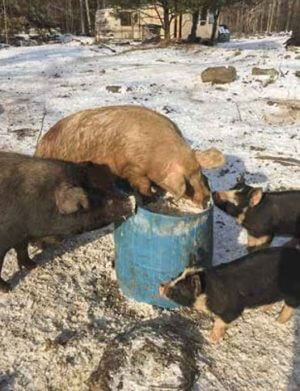 diversify their operations by incorporating livestock, which has the added benefit of generating manure. Rather than importing commercial feed, utilizing local food scraps as feed more closely aligns with the ultimate goal of reducing imported fertility. While most food is technically imported, since the scraps typically come from local generators, they can be viewed as a local resource (people have to eat), in effect replacing imported fertility in the system. Ultimately, both farmers and composters would like to see more local food replace imported food to create a truly closed-loop food system.
diversify their operations by incorporating livestock, which has the added benefit of generating manure. Rather than importing commercial feed, utilizing local food scraps as feed more closely aligns with the ultimate goal of reducing imported fertility. While most food is technically imported, since the scraps typically come from local generators, they can be viewed as a local resource (people have to eat), in effect replacing imported fertility in the system. Ultimately, both farmers and composters would like to see more local food replace imported food to create a truly closed-loop food system.
Schools are often a source of both pre- and post-consumer food scraps. A school might partner up with a small chicken farm in a one-to-one generator-to-composter relationship. This would constitute a micro program in a community whereby the farm serves as food scrap recycler for one or several small generators. Often the school is the entry point for a program that might then grow to serve residential drop-offs, a small grocery, several schools, and so on, in that community. For example, 1 ton per week of food scraps could likely be captured from a 700-student elementary school, a 400-student middle school, and a residential drop-off in a town with a population of 10,000 people. In turn, 1 ton per week could feed approximately 140 laying hens.
Another common benefit of incorporating animals into a composting operation is potentially controversial in some circles of the organics recycling industry (and a no-brainer in others). By upcycling food residuals as an animal feed, you effectively transfer the recycling of “solid waste” into the agricultural domain. The language may vary from state to state, but logic puts this squarely in the realm of agricultural activity, and, as mentioned earlier, agricultural activities have far fewer regulatory requirements in general than do solid waste management activities and other non-agricultural commercial activities. It’s a huge benefit, and while by no means do I advocate composters using this as a backdoor path to skirt regulations (say, 50 chickens at a compost facility that processes 20 tons per week of scraps), if you’re passionate about both animal husbandry and composting, combining the two deserves your serious consideration. Unfortunately, during the writing of this book at least one very progressive state has moved to exclude this practice from their definition of agriculture, so those who utilize this practice would do well to band together as have others fighting for the right to restore and maintain the natural integrity of our food system.
When you compare composting with animals to a standard turned windrow or bin composting system, there is a significant reduction in scale that translates across the system to a reduction of footprint, labor, cost, feedstock requirements, and so on. A theoretical “composting with chickens” operation is sized later in this chapter; it’s comparable in capacity to systems covered in other chapters. For a chicken composting operation that can process 10 tons per week of food scraps, the composting portion of the operation requires only 10 to 50 percent of the composting footprint/capacity of a comparably sized composting operation, depending upon the volume that the chickens don’t consume.
Essentially, composting with animals, like technologies such as ASP, windrow turners, and in-vessel systems, can increase the food scrap processing capacity of a farm without increasing the compost site footprint. Land can be used for raising animals and other food ventures rather than compost production. In rural areas and on the outskirts of cities are farms with barns, manure pits, silage bunks, greenhouses, and other existing infrastructure that can easily be converted for composting with animals, whereas these spaces are often harder to efficiently convert and permit for stand-alone composting operations.
Lastly, there are a host of other anecdotal benefits that I have heard reported by operators (largely chicken composters), including reduced fly populations, reduced exposed food on pile surface, increased feed value (biological and feed diversity), eggs for employees, and overall increases in employee job satisfaction. Farm animals provide a host of other valuable services, such as clearing, weeding, fertilizing, and otherwise preparing land for crops, to name just a few. All of these can be compatible with composting.
Recommended Reads
Recent Articles
Want to get started with silvopasture? The first step is figuring out which type of livestock works best for your ecosystem.
Read MoreExtend Your Growing Season with a Cold Frame! Plant earlier in spring AND grow later into fall. Build your own cold frame and enjoy a longer harvest season! Ready to grow more, longer?
Read MoreGrowing year-round is a challenge, but it’s not impossible. Follow these growing tips, and you’ll be well on your way to growing year-round!
Read MoreNo heated greenhouse? No problem! Discover the secrets to thriving winter gardening without breaking the bank.
Read More

